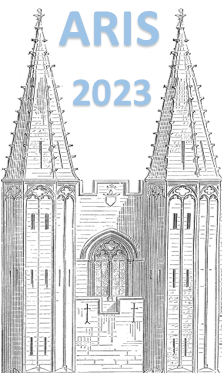Orateur
Description
The development of collectivity along the $N=Z$ is one of the subjects that has recently attracted great experimental efforts. In particular, heavy $N=Z$ nuclei in the mass region $A=80$ are expected to be some of the most deformed ground states which have been found [1] in mid-mass nuclei, typically $8p-8h,12p-12h$ for e.g. the cases of $^{76}$Sr, $^{80}$Zr. This strong enhancement of collectivity with respect to lighter $N=Z$ nuclei has its origin
in cross shell excitations across the $N=40$ shell gap to $g9/2$, $d5/2$ and $s1/2$ which are intruder quadrupole partners generating deformations.
These structures can be interpreted in terms of algebraic Nilsson-SU3 self-consistent model to describe the intruder relative evolution in the vicinity of $^{80}$Zr [2]. In this presentation, we will expose some of the latest developments in microscopic nuclear structure calculations for exotic nuclei far from stabilitity at the N=Z [3].
The new theoretical calculations for the very region of $^{80}$Zr will be presented for the first time within the interacting shell model framework using an enlarged model space outside a $^{56}$Ni core comprising the pseudo-SU3 $p_\frac{3}{2}f_\frac{5}{2}p_\frac{1}{2}$ and quasi-SU3 $g_\frac{9}{2}d_\frac{5}{2}s_\frac{1}{2}$ orbitals for both protons and neutrons. We will present and compare results from both exact Shell Model diagonalization [4] and our newly developed DNO Shell Model approach employing beyond mean field techniques [5]. These theoretical calculations allow a very good description of the rapid transition ($A=60-100$) from spherical to deformed structures which can be intepreted in terms of ``simple'' many particles - many holes configurations. Emphasis will be put on the intimate relationship between shell evolution far from stability at the neutron-rich AND proton-rich edges.
[1] R. D. O. Llewellyn et al., Phys. Rev. Lett. 124, 152501 (2020).
[2] A. P. Zuker et al., Phys. Rev. C 92, 024320 (2015)
[3] D. D. Dao, F. Nowacki, A. Poves in preparation
[4] E. Caurier, G. Martínez-Pinedo, F. Nowacki, A. Poves, and A. P. Zuker, Rev. Mod. Phys. 77, 427 (2005).
[5] D. D. Dao and F. Nowacki, Phys. Rev. C 105, 054314 (2022).

